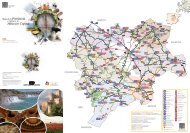1ª PARTE GUIA RESTAURANTE.indd - Turismo en Albacete
1ª PARTE GUIA RESTAURANTE.indd - Turismo en Albacete
1ª PARTE GUIA RESTAURANTE.indd - Turismo en Albacete
Create successful ePaper yourself
Turn your PDF publications into a flip-book with our unique Google optimized e-Paper software.
16<br />
<strong>RESTAURANTE</strong>S ALBACETE Y PROVINCIA<br />
Productos con d<strong>en</strong>ominación<br />
designation of origin<br />
MANCHEGO CHEESE<br />
The product of a harsh climate and A rustic and arid vegetation. Manchego cheese is not a<br />
random product, but the result of the need to preserve the ewe milk production.<br />
DO Manchego Cheese has special requirem<strong>en</strong>ts like a production made with manchego<br />
ewe’s milk and a maturation period of at least sixty days and maximum two years. Milk<br />
can be pasteurized or not.<br />
Manchego cheese has a strong, greasy and oily flavor, with a good bouquet and aftertaste.<br />
Manchego cheese is undoubtedly the most famous cheese in Spain, unique in the world,<br />
both for its aroma and flavor as well as its nutritional quality.<br />
A popular saying states that “Eating cheese and drinking good wine the way is made<br />
easily”.<br />
Manchego cheese is also found in other regions of the province: La Manchuela, Almansa,<br />
Campos de Hellin, Sierra de Alcaraz and Campo de Montiel.<br />
Manchego Cheese Regulatory Board www.quesomanchego.es<br />
MANCHEGO LAMB<br />
The manchego lamb meat comes exclusively from Manchego Sheep breed. There are two<br />
types of Manchego sheep: white and black.<br />
The Manchego sheep, offers a double productive aptitude: milk and meat. The breeding of<br />
these lambs is made in ext<strong>en</strong>sive, breast feeding them and supplem<strong>en</strong>ted with the natural<br />
pastures of La Mancha.<br />
Their habitat in the province of <strong>Albacete</strong> includes the following counties: <strong>Albacete</strong>.<br />
Manchajucar, Manchuela, Sacam, Campos de Hellin and Almansa.<br />
Manchego Lamb Regulatory Board www.corderomanchego.org<br />
D.O. MANCHA WINES<br />
The DO Mancha is based on the Spanish largest natural region, <strong>en</strong>compassing part of the<br />
provinces of <strong>Albacete</strong>, Ciudad Real, Cu<strong>en</strong>ca and Toledo, and repres<strong>en</strong>ting the largest winegrowing<br />
association in the world.<br />
Its area of over 191,000 hectares. produces a wide variety of wines, being the largest area<br />
dedicated to grow the Air<strong>en</strong> white variety; the vines are pruned very short, creeping its<br />
branches grow full to retain as much soil moisture as possible. Among the red grapes,<br />
the main one is the C<strong>en</strong>cibel, of high quality. Other grape varieties are Cabernet Saugvinon,<br />
Macabeo, Pardilla, Gr<strong>en</strong>ache, Merlot, Syrah and Moravia<br />
Wines DO “La Mancha” Regulatory Board : www.lamanchado.es<br />
ONION<br />
The collective quality trade mark “Onion from La Mancha” focuses on the varieties “Recas<br />
type”. Its features are: an int<strong>en</strong>se copper color on the outside, almost perfectly round<br />
shape, large size,excell<strong>en</strong>t preservation qualities and a high conc<strong>en</strong>tration of pyruvic acid.<br />
Onions are grown along 4 provinces of CLM: <strong>Albacete</strong>, Ciudad Real, Cu<strong>en</strong>ca and Toledo.<br />
PROCECAM (CLM Onion-Producers Association) www.procecam.es<br />
Other products in this area with the label D.O. are also saffron, oil, game meat and honey.<br />
QUESO MANCHEGO<br />
Producto de un clima duro y de una vegetación árida y rústica. No es fruto del azar, sino<br />
de una necesidad: conservar la leche.<br />
La DO Queso Manchego obliga a que su elaboración se realice con leche de oveja de raza<br />
manchega y con un periodo de maduración de al m<strong>en</strong>os ses<strong>en</strong>ta días y máximo dos años.<br />
La leche puede estar pasteurizada o no.<br />
El queso manchego es un queso de sabor fuerte, mantecoso y aceitoso, de bu<strong>en</strong> buqué<br />
y retrogusto.<br />
El queso manchego es sin duda el queso más famoso de España, único <strong>en</strong> el mundo tanto<br />
por su aroma y sabor como por sus cualidades alim<strong>en</strong>ticias.<br />
Comi<strong>en</strong>do bu<strong>en</strong> queso y bebi<strong>en</strong>do bu<strong>en</strong> vino se hace el camino.<br />
El queso manchego también se da <strong>en</strong> otras comarcas: La Manchuela, Almansa, Hellín,<br />
Sierra de Alcaraz y Campo de Montiel.<br />
Consejo Regulador Queso Manchego www.quesomanchego.es<br />
CORDERO MANCHEGO<br />
La carne de cordero manchego procede exclusivam<strong>en</strong>te de la raza Manchega.<br />
La oveja manchega ofrece una doble aptitud de producción: leche y carne. La cría de estos<br />
corderos se realiza <strong>en</strong> régim<strong>en</strong> ext<strong>en</strong>sivo alim<strong>en</strong>tándose de la leche materna completada<br />
con los pastos naturales de La Mancha. Hay dos tipos de oveja manchega: la blanca y la<br />
negra.<br />
Su hábitat <strong>en</strong> <strong>Albacete</strong> compr<strong>en</strong>de las sigui<strong>en</strong>tes comarcas: <strong>Albacete</strong> capital, Mancha-<br />
Júcar, La Manchuela, Sacam, Campos de Hellín y Almansa.<br />
Consejo regulador DO Cordero manchego: www.corderomanchego.org<br />
VINOS CON D.O. LA MANCHA<br />
La D.O. Vinos de La Mancha se asi<strong>en</strong>ta sobre la comarca natural más grande de España,<br />
<strong>en</strong>globando parte de las provincias de <strong>Albacete</strong>, Ciudad Real, Cu<strong>en</strong>ca y Toledo, y constituye<br />
la mayor agrupación vitícola del mundo.<br />
Su superficie de mas 191.000 ha supone una amplia variedad de vinos dedicándose la<br />
mayor ext<strong>en</strong>sión al cultivo de la variedad blanca Airén; sus cepas se podan muy cortas,<br />
creci<strong>en</strong>do rastreros sus sarmi<strong>en</strong>tos para ret<strong>en</strong>er al máximo la humedad del suelo. Entre<br />
las uvas tintas, la principal es la C<strong>en</strong>cibel, de gran calidad. Otras variedades de uva son<br />
Cabernet Saugvinon, Macabeo, Pardilla, Garnacha, Merlot,syrah y Moravia<br />
Consejo regulador Vinos DO “la Mancha”: www.lamanchado.es<br />
CEBOLLA DE LA MANCHA<br />
La Marca de calidad colectiva “Cebolla de La Mancha” se c<strong>en</strong>tra <strong>en</strong> las variedades “tipo<br />
Recas”. Sus características son color cobrizo int<strong>en</strong>so <strong>en</strong> el exterior, su redondez casi perfecta,<br />
su gran tamaño, sus cualidades de conservación y su alta conc<strong>en</strong>tración <strong>en</strong> ácido pirúvico.<br />
La cebolla se exti<strong>en</strong>de <strong>en</strong> cuatro provincias de C-LM: <strong>Albacete</strong>, Ciudad Real, Cu<strong>en</strong>ca<br />
y Toledo.<br />
PROCECAM (Asociación Productores de Cebolla C-LM) www.procecam.es<br />
Otro producto con D.O. <strong>en</strong> esta comarca es el azafrán y también el aceite, el ajo, la caza,<br />
la pesca y la miel.



